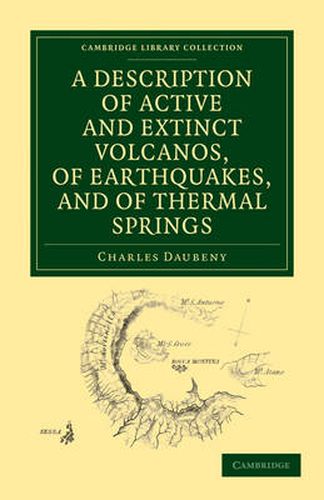Readings Newsletter
Become a Readings Member to make your shopping experience even easier.
Sign in or sign up for free!
You’re not far away from qualifying for FREE standard shipping within Australia
You’ve qualified for FREE standard shipping within Australia
The cart is loading…






Charles Daubeny (1795-1867) first published Active and Extinct Volcanos in 1826. This reissue is of the second, augmented edition of 1848, which the author explains was significantly updated in the light of the work of Charles Darwin. Part I contains geological descriptions of most of the world’s known volcanos, arranged by region, many of them based on Daubeny’s own observations. Part II contains descriptions of earthquake-prone regions, thermal springs, and thermal waters. In Part III Daubeny introduces his influential theory of the causes of volcanic action, proposing that it results from contact between water and metals beneath the earth’s surface. He also discusses the factors that give volcanos particular characteristics, and the impact of volcanos on their environments. This pioneering work of Victorian geology provided the scientific community with some of the first descriptions and data sets on previously unstudied volcanic regions, and is still referred to today.
$9.00 standard shipping within Australia
FREE standard shipping within Australia for orders over $100.00
Express & International shipping calculated at checkout
Stock availability can be subject to change without notice. We recommend calling the shop or contacting our online team to check availability of low stock items. Please see our Shopping Online page for more details.
Charles Daubeny (1795-1867) first published Active and Extinct Volcanos in 1826. This reissue is of the second, augmented edition of 1848, which the author explains was significantly updated in the light of the work of Charles Darwin. Part I contains geological descriptions of most of the world’s known volcanos, arranged by region, many of them based on Daubeny’s own observations. Part II contains descriptions of earthquake-prone regions, thermal springs, and thermal waters. In Part III Daubeny introduces his influential theory of the causes of volcanic action, proposing that it results from contact between water and metals beneath the earth’s surface. He also discusses the factors that give volcanos particular characteristics, and the impact of volcanos on their environments. This pioneering work of Victorian geology provided the scientific community with some of the first descriptions and data sets on previously unstudied volcanic regions, and is still referred to today.